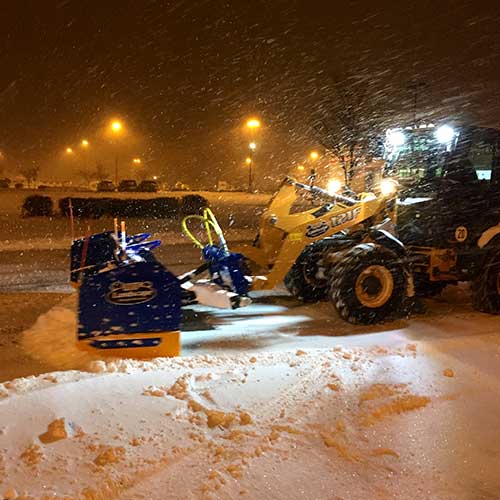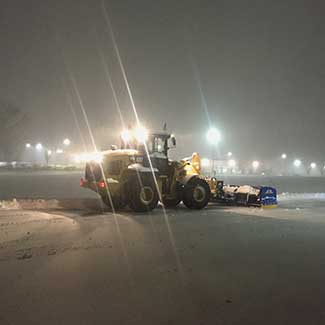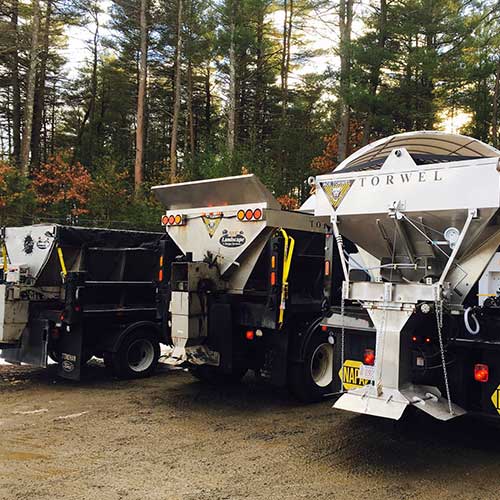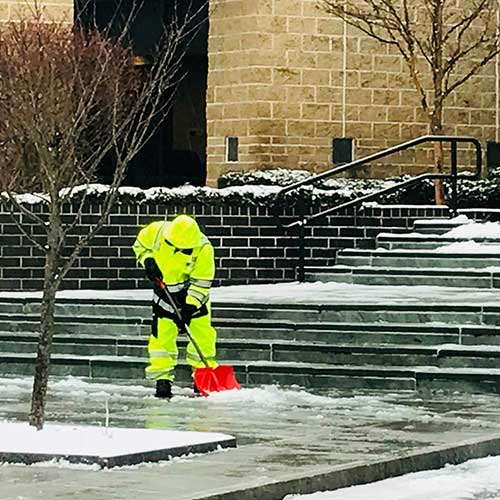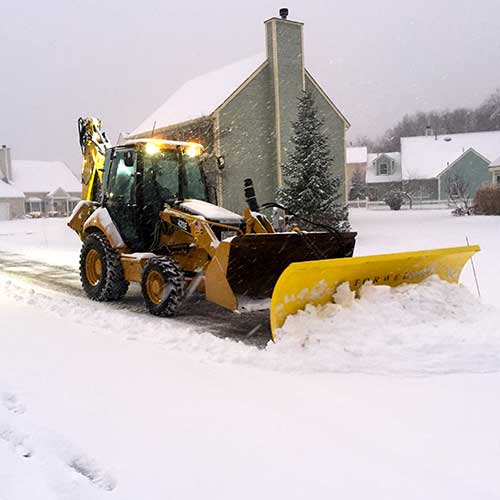Premier Newton
Snow Removal Company
Looking for a Newton Snow Removal Company?
Are you a Business Owner? Property Manager? Or maybe someone just looking for more information on a top notch Newton snow removal company.
You’re in the right place…
DO YOU HAVE THESE PROBLEMS:
• Not happy with existing snow plowing contractor?
• New business owner?
• Accepting new bids for existing property?
• In need of immediate snow removal services?
• Need bigger equipment or team to manage your properties?
MF Landscape & Design‘s commercial snow removal services have helped thousands of business owners, property managers, and other individuals in Newton, MA and the surrounding communities plow, sand, salt, shovel, and maintain their parking lots, walkways, and stairs. We understand the liability and know how to prevent potential problems for you, your customers, and your employees.
After some research, we’re confident you’ll find us to be the right ice and snow management company to handle your snow removal needs.
Why Choose
MF Landscape & Design as your Commercial Snow Removal Company in Newton, MA?
In short… Because we have a reputation for quality work at a fair price. Our customer service is second to none. Our team is always responsive, courteous, friendly, and respectful.
At MF Landscape and Design, we do it all! From conception through to completion, we handle every aspect of snow removal, snow hauling, ice management, as well as shoveling of walkways and steps.
With MF Landscape & Design, you’ll receive:
- Quality workmanship that is guaranteed to last
- Work form licensed professionals who are honest and hardworking
- Dependable service that is completed on time and on budget
- Financing options to help fund your yard and garden projects
- Free estimates and a fully insured crew
To review the creativity of our design and the quality of our craftsmanship, simply take a look at our Photo Gallery. Our decades worth of landscaping projects speak for themselves! From custom landscape designs to planting projects, patios, stonework, snow removal, and more — You can trust your yard or business property to our team of experts.
Benefits of
Snow Removal:
Prevent Accidents
Use Specialized Equipment
Prevent Lost Income
Safety and Liability
24-hour Service
Photo Gallery of our Snow Removal Company at work
Snow Removal, Plowing, and Salting Services Avoids Loss Of Business and Liability
We have the equipment, knowledge, and skill necessary to expedite the process so that, whether you own a storefront, a manufacturing facility, or an office building, your commercial property won’t be hindered by heavy snowfall and ice. Fully licensed, insured and always furthering our education to most efficiently serve our clients. Professionally seasoned with over a decade of in-the-field, hands-on experience.
Best Time To Contact A Snow Removal Company?
Now! Today!!
★★★★★
Top-Rated Landscaper
Focused On Service And Delivering Quality
Welcoming New Customers From
Newton, Massachusetts
More About Newton, MA
Newton is a city in Middlesex County, Massachusetts, United States. It is approximately 7 miles (11 km) west of downtown Boston. Newton resembles a patchwork of thirteen villages, without a city center. According to the 2020 U.S. Census, the population of Newton was 88,923.
Newton was settled in 1630 as part of “the newe towne”, which was renamed Cambridge in 1638. Roxbury minister John Eliot persuaded the Native American people of Nonantum, a sub-tribe of the Massachusett led by a sachem named Waban, to relocate to Natick in 1651, fearing that they would be exploited by colonists. Newton was incorporated as a separate town, known as Cambridge Village, on December 15, 1681, then renamed Newtown in 1691, and finally Newton in 1766. It became a city on January 5, 1874. Newton is known as The Garden City.
In Reflections in Bullough’s Pond, Newton historian Diana Muir describes the early industries that developed in the late 18th and early 19th centuries in a series of mills built to take advantage of the water power available at Newton Upper Falls and Newton Lower Falls. Snuff, chocolate, glue, paper and other products were produced in these small mills but, according to Muir, the water power available in Newton was not sufficient to turn Newton into a manufacturing city, although it was, beginning in 1902, the home of the Stanley Motor Carriage Company, the maker of the Stanley Steamer.
Newton, according to Muir, became one of America’s earliest commuter suburbs. The Boston and Worcester, one of America’s earliest railroads, reached West Newton in 1834. Wealthy Bostonian businessmen took advantage of the new commuting opportunity offered by the railroad, building gracious homes on erstwhile farmland of West Newton hill and on Commonwealth street. Muir points out that these early commuters needed sufficient wealth to employ a groom and keep horses, to drive them from their hilltop homes to the station.
Further suburbanization came in waves. One wave began with the streetcar lines that made many parts of Newton accessible for commuters in the late nineteenth century. The next wave came in the 1920s when automobiles became affordable to a growing upper middle class. Even then, however, Oak Hill continued to be farmed, mostly market gardening, until the prosperity of the 1950s made all of Newton more densely settled.
Two of the 9/11 hijackers stayed in Newton the night before the attack. The hijackers of American Airlines Flight 11 spent their last night in Newton’s Park Inn, an economy motel across the street from the Chestnut Hill Mall and within walking distance of The Atrium.
Each April on Patriots’ Day, the Boston Marathon is run through the city, entering from Wellesley on Route 16 (Washington Street) where runners encounter the first of the four infamous Newton Hills. It then turns right onto Route 30 (Commonwealth Avenue) for the long haul into Boston. There are two more hills before reaching Centre Street, and then the fourth and most noted, Heartbreak Hill, rises shortly after Centre Street. Residents and visitors line the race route along Washington Street and Commonwealth Avenue to cheer the runners.
Newton is a suburban city approximately 7 mi (11 km) from downtown Boston, in Middlesex County, Massachusetts. It is also bordered by Waltham and Watertown on the north, Needham and the West Roxbury neighborhood of Boston on the south, Wellesley and Weston on the west, and Brookline and the Brighton neighborhood of Boston on the east.
The Charles River flows along the north and west parts of Newton, and Route 128 passes through the west part of the city.
The Massachusetts Turnpike goes through the more urbanized northern section of the city before heading into Boston. Additional major highways in Newton include Route 9, serving the southern parts of the city, and Hammond Pond Parkway, which is the main north–south route through Chestnut Hill and provides access to Brookline and West Roxbury.
According to the United States Census Bureau, the city has a total area of 18.2 square miles (47.1 km), of which 18.0 square miles (46.6 km2) is land and 0.2 square miles (0.5 km) (0.82%) is water.
Geologically Newton located within topographic lowland the Boston Basin of the Appalachian Mountain chain. This lowland is surrounded by a ring of highland drumlins which were left after the last glaciation twelve thousand years ago.
There are several unique outcroppings of rocks around Newton where geologic history revealing of how territory have formed and has changed over the past hundreds millions of years of drift supercontinents and ancient oceans, earthquake activity associated with volcanism and related faulting activity and changing climate. There are mainly three types of bedrock: Roxbury Conglomerate, Cambridge Argillite or Slate, and Brighton Volcanics and the Mattapan Volcanics pre-Cambrian foundation of Dedham Granodiorite. The Boston Border Fault and the Shawmut anticline of Newton formed as the alpine mountains of east-central Massachusetts were created. Unique outcroppings rocks exposure has steadily declined as Newton area has become increasingly developed.
Newton has grown around a formation of seven hills. “The general features of Newton are not without interest. Seven principal elevations mark its surface, like the seven hills of ancient Rome, with the difference that the seven hills of Newton are much more distinct than the seven hills of Rome: Nonantum Hill, Waban Hill, Chestnut Hill, Bald Pate Hill, Oak Hill, Institution Hill and Mount Ida.”
Rather than having a single city center, Newton is a patchwork of thirteen villages, many boasting small downtown areas of their own. The 13 villages are: Auburndale, Chestnut Hill, Newton Centre, Newton Corner, Newton Highlands, Newton Lower Falls, Newton Upper Falls (both on the Charles River, and both former small industrial sites), Newtonville, Nonantum (also known as Silver Lake or “The Lake”), Oak Hill, Thompsonville, Waban and West Newton. Oak Hill Park is a place within the village of Oak Hill that itself is shown as a separate and distinct village on some city maps (including a map dated 2010 on the official City of Newton website), and Four Corners is also shown as a village on some city maps. Although most of the villages have a post office, they have no legal definition and no firmly defined borders. This village-based system often causes some confusion with addresses and for first-time visitors.
The record low temperature was −21 °F (−29 °C) in February 1934; the record high temperature was 101 °F (38 °C) in August 1975.
As of the census of 2010, there were 85,146 people, 32,648 households, and 20,499 families residing in the city. The population density was 4,643.6 inhabitants per square mile (1,792.9/km2). There were 32,112 housing units at an average density of 1,778.8 per square mile (686.8/km). The racial makeup of the city was 79.6% White, 11.5% Asian, 2.5% African American, 0.07% Native American, 0.03% Pacific Islander, 0.71% from other races, and 1.46% from two or more races. Hispanic or Latino of any race were 4.1% of the population (0.7% Puerto Rican, 0.6% Mexican, 0.4% Colombian, 0.3% Guatemalan, 0.3% Argentine). (2010 Census Report: Census report Quickfacts.com)
Newton, along with neighboring Brookline, is known for its considerable Jewish and Asian populations. The Jewish population as of 2002 was estimated as roughly 28,002.
There were 31,201 households, out of which 31.1% had children under the age of 18 living with them, 55.2% were married couples living together, 8.0% had a female householder with no husband present, and 34.3% were non-families. Of all households, 25.5% were made up of individuals, and 11.1% had someone living alone who was 65 years of age or older. As of the 2008 US Census, the average household size was 2.60 and the average family size was 3.11.
In the city, the population was spread out, with 21.2% under the age of 18, 10.3% from 18 to 24, 28.2% from 25 to 44, 25.2% from 45 to 64, and 15.1% who were 65 years of age or older. The median age was 39 years. For every 100 females, there were 86.8 males. For every 100 females age 18 and over, there were 82.7 males.
The median income for a household in the city was $107,696, and the median income for a family was $136,843. Males had a median income of $95,387 versus $60,520 for females. The per capita income for the city was $56,163. About 3.6% of families and 5.9% of the population were below the poverty line, including 5.2% of those under age 18 and 9.4% of those age 65 or over.
As of 2015, 21.9% of the residents of Newton were born outside of the United States.
Newton’s largest employers include Boston College and Newton-Wellesley Hospital. Companies based in Newton include TechTarget, CyberArk and Upromise. Until July 2015, Newton was also home to the global headquarters of TripAdvisor, the world’s largest travel site, reaching nearly 280 million unique monthly visitors. TripAdvisor moved into a newly built headquarters in neighboring Needham.
Data is from the 2009–2013 American Community Survey 5-Year Estimates.
The city has two symphony orchestras, the New Philharmonia Orchestra of Massachusetts and the Newton Symphony Orchestra. The Joanne Langione Dance Center, an American youth dance school was founded in 1976.
Newton has an elected strong mayor-council form of government. The council is called the City Council. The mayor is Ruthanne Fuller. Fuller is the first woman to be elected Mayor of Newton.
The elected officials are:
As of October 2021, the makeup of the City Council is:
Newton’s school committee decides policies and budget for Newton Public Schools. It has nine voting members, consisting of the Mayor of Newton and eight at-large Ward representatives, who are elected.
Mismanagement of Middlesex County’s public hospital in the mid-1990s left the county on the brink of insolvency, and in 1997 the Massachusetts legislature stepped in by assuming all assets and obligations of the county. The government of Middlesex County was officially abolished on July 11, 1997. The sheriff and some other regional officials with specific duties are still elected locally to perform duties within the county region, but there is no county council or commission. However, communities are now granted the right to form their own regional compacts for sharing services.
These are the remaining elected officers for Middlesex County:
House of Representatives:
Senate:
Congress
Public education is provided by Newton Public Schools.
Colleges and universities located in Newton include:
Newton Junior College, operated by the Newton Public Schools, opened in 1946 to serve the needs of returning veterans who otherwise would not have been able to continue their education due to the overcrowding of colleges and universities at that time. It used the facilities of Newton High School (now Newton North High School) until its own adjacent campus was built. It closed in 1976 due to declining enrollment and increased costs. The availability of such places as UMass Boston contributed to its demise. According to the city, its former campus is now “Claflin Park,” a 25-unit multi-family development.
Other former colleges include Aquinas College (1961–1999), Mount Alvernia College (1959–1973), Mount Ida College (1899–2018), and Newton College of the Sacred Heart (1946–1975). Andover Newton Theological School relocated to New Haven, CT (1807–2017).
The city’s community newspapers are The Newton TAB, a weekly print paper published by the Community Newspaper Company, and owned by Gatehouse Media. The Newton Patch covers daily local news out of Newton and offers a platform for locals to post opinion, events, news tips and blogs on the community online platform as well. The Newton Voice. The Newton community is also served by its high school publications, including Newton North High School’s Newtonite and Newton South High School’s Lion’s Roar and Denebola. The Boston Globe occasionally covers Newton.
Residents of Newton have access to a state-of-the-art television studio and community media center, NewTV, located at 23 Needham Street in Newton Highlands. Newton is also home to NECN, a regional news network owned by NBC.
From 1968 to 2017, the studios and transmitter of WNTN AM-1550 were on Rumford Avenue in Auburndale.
Newton-Wellesley Hospital is located at 2014 Washington Street in Newton. U.S. News & World Report ranks the hospital 13th best in the Boston metro area.
Newton’s proximity to Boston, along with its good public schools and safe and quiet neighborhoods, make it a very desirable community for those who commute to Boston or work in Newton’s businesses and industries.
Newton is well-served by three modes of mass transit run by the MBTA: light rail, commuter rail, and bus service. The Green Line D branch, (also known as the Riverside branch) is a light rail line running through the center of the city that makes very frequent trips to downtown Boston, ranging from 10 to 30 minutes away. The Green Line B branch ends across from Boston College on Commonwealth Avenue, virtually at the border of Boston’s Brighton neighborhood and the City of Newton (an area which encompasses an unincorporated suburban village referred to as Chestnut Hill). The MBTA Worcester commuter rail, serving the northern villages of Newton that are proximate to Waltham, offers less frequent service to Boston. It runs from every half-an-hour during peak times to every couple of hours otherwise. The northern villages are also served by frequent express buses that go to downtown Boston via the Massachusetts Turnpike as well as Waltham.
Newton Centre, which is centered around the Newton Centre MBTA station, has been lauded as an example of transit-oriented development.
The Massachusetts Turnpike (Interstate 90), which basically follows the old Boston and Albany Railroad main line right-of-way, runs east and west through Newton, while Route 128 (Interstate 95) slices through the extreme western part of the city in the Lower Falls area. Route 30 (Commonwealth Avenue), Route 16 (Watertown Street west to West Newton, where it follows Washington Street west) and route 9 (Worcester Turnpike or Boylston Street) also run east and west through the city. Another major Boston (and Brookline) street, Beacon Street, runs west from the Boston city line to Washington Street west of the hospital, where it terminates at Washington Street.
There are no major north–south roads through Newton: every north–south street in Newton terminates within Newton at one end or the other. The only possible exception is Needham Street, which is north–south at the border between Newton and Needham, but it turns east and becomes Dedham Street, and when it reaches the Boston border, it goes south-east.
There are some north–south streets that are important to intra-Newton traveling. Centre Street runs south from the Watertown town line to Newton Highlands, where it becomes Winchester Street and terminates at Nahanton Street. Walnut Street runs south from Newtonville, where it starts at Crafts Street, down to Newton Highlands, where it ends at Dedham Street.
The City of Newton Police Department has 139 sworn officers. The Newton Fire Department is fully paid and operates six engine companies, three ladder companies, and one rescue company from six stations.
Newton is currently twinned with:
Ice Management & Sanding
Many business owners believe that going outside to occasionally spread salt around is sufficient to keep their pathways safe. Controlling ice is not an easy thing to do when weather conditions are severe like they often are in Massachusetts. Effective ice control requires the experience gained from over a decade of snow and ice management. A fleet of heavy equipment and a large group of full time and seasonal employees are all prepared to mobilize 24/7.
Snow Shoveling And Walkway De-icing
When you consider a commercial snow removal service, you may be thinking snow plows, and other heavy-duty equipment rolling out to clear expansive parking lots and roadways – but your sidewalks and entryways will also need attention. MF Snow Management is a full service enterprise. We are equipped to handle the big jobs, but we also have machinery that is particularly functional for the smaller ones. We have snow blowers that we use to remove light accumulations, and others for deep snow removal.
Talk to an Expert
We understand that sometimes you just want to talk before scheduling a consultation.
Our team will gladly answer any of your questions or help you with any of your concerns.
Call (508) 404-4819 now!
Snow Removal For These Types Of Businesses
- Retail Stores
- Gas Stations
- Movie Theatres
- Grocery Stores
- Malls
- Industrial Offices
- Restaurants
- Apartment Complexes
- Multi-use Commercial buildings
- Parking Lots
- Medical Offices
- Hospitals
- Health Care Facilities
- Gyms
- Car Dealerships
- And More!
Don’t see your business type on the list? No Problem! If your business needs help with snow plowing, give us a call and we’d be happy to come to take a look at your property and give you a fair estimate to manage things for the entire winter.
